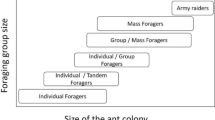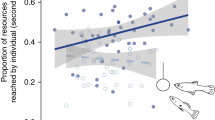Summary
A series of experiments shows how the andLasius niger uses its trail recruitment system to select between two food sources. Simultaneously presented with to 1M sucrose solution it concentrates on one of them. When offered a 1M solution together with a 0.1M solution it selects the richer source, unless the trait to the 0.1M source had become well-developed before the 1M source was introduced. In the same situation, however, the group/mass recruiting antTetramorium caespitum uses its more individual transmission of information to switch to the 1M source. A mathematical model describes these processes and its dynamics reflect the experimental results.
Resume
Nous présentons une série d'expëriences qui montrent comment la fourmiLasius niger peut utiliser son système des recruitement par piste afin de sélectionner une dfes deux sources de nourriture. Sil on leur offire simultanément deux solution 1M de saccharose, la sojciét'e concentre son activité sur l'une des deux. Si l'on offre deux solutions, une de 1M et l'autre de 0.1M, elle sélectionne la plus riche, à mons que la piste qui mène à la source 0.1M soit déjà bien développée au moment où l'on introduit la source 1M. Face à la même situation, la fourmiTetramorium caespitum, qui recrute par groupe/masse, utilise son mode de transmission d'information plus, individuel pour changes son exploitation vers la source 1M. Un modèle mathématique décrit ces processus, dont la dynamique correspond bien aux observations expérimentales.
Similar content being viewed by others
References
Brown C.r., 1986. — Cliff swallow colonies as information centers.Science, 234, 83.
Chadab R., Rettenmeyer C.W., 1975. — Mass recruitment by army ants.Science, 188, 1124–1125.
Cornetz V., 1914. —Les Explorations et les Voyages des Fourmis, Flammarion, Paris.
Crawford D.L., Rissing S.W., 1983. — Regulation of recruitment by individual scouts inFormica oreas Wheeler (Hymenoptera; Formicidae).Soc. Inst., 30, 177–183.
DeGroot P., 1980. — Information transfer in a socially roosting weaver bird (Quelea quelae): Ploceinae): an experimental study.Anim. Behav., 28, 1249–1258.
Deneubourg J.L., Pasteels J.M., Verhaeghe J.-C., 1982. — Probabilistic behaviour in ants: a strategy of erros?J. Theor. Biol. 105, 259–271.
Edelstein-Keshet L., 1988. —Mathematical Models in Biology. Random House/Birkaüser.
Emlen S.T., Demong N.J., 1975. — Adaptive significance of synchronised breeding in a colonical bird.Science, 188, 1029.
Fitzgerald T.D., Peterson S.C., 1983. — Electrive recruitment communication by the eastern tent caterpillar (Malacosoma americanum).Anim. Behav., 31, 417–423.
Fitzierald T.D., Peterson S.C., 1988. — Cooperative foraging and communication in caterpillars.Bioscience, 38, 20–25.
Fowler H.G., 1987. — Communication and optimal foraging in the ant Tetramorium caespitum (Hymenoptera: Formicidae).Cienia y Cultura, 39, 301–303.
Glansdorff P., Aprigogine I., 1971. —Thermodynamics of Structure, Stability and Fluctuations. Wiley-Interscience, New York.
Gotmark F., Winkler D.W., Andersson M., 1986., — Flock-feeding on fish schools increases individual success in gulls.Nature, 319, 589.
Greene E., 1987. — Individuals in an osprey colony discriminate between high and low quality information.Nature, 329, 239.
Hangartner W., 1969. — Structure and variability of the individual odor trial inSolenopsis geminata Fabr. (Hymenoptera, Formicidae),Zeit. Vergl. Physiol., 62, 111–120.
Höllbobler, B., 1978. — Ethological aspects of chemical communication in ants. In: Rosenblatt J.S., Hinde R.A, Berr C., Bushnel M. (eds.)Advances in the study of Animal Behavior, Academic Press, New-York, pp. 75–115.
Lefebvre L., 1983. — Equilibrium distribution of feral pigeons at multiple food sources.Behav. Ecol. Sociobiol., 12, 11–17.
Leuthold R.H., 1975. — Orientation mediated by pheromones in social insects. In: Noirot P., Howse P., Le Masne G. (eds.),Pheromones and defensive secretion in social insects. Proc. symp. IUSSI, Université de Dijon.
Alindauer M., 1949. — Über die Einwirkung von Duft-und-Geschmacksstoffen so wie andere Faktoren auf die Tänze der Bienen.Zeit. fürVergl. Physiol., 31, 348–412.
Lindauer M., 1954. — Temperaturregulierung und Wasserhaushalt in Bienenstaat.Zeit. für Vergl. Physiol., 36, 391–432.
Alindauer M., 1955. — Schwarmbienen auf Wohnungssuche.Zeits. Verg. Physiol., 37, 263.
Lindauer M., 1961. —Communication Among Social Bees. Harvard University Press, Cambridge, Mass., 143 pp.
Möglich M., Maschwitz U., Hölldobler B., 1974. — Tandem calling: a new kind of signal in ant recruitment.Science 186, 1046.
Nicolis G., Prigogine I.,. 1977. —Selfe-Organisation in Non-equilibrium Systems.Wiley-Interscience, New York, 491 pp.
Passera L. 1984. —L'Organisation Sociale des Fourmis. Privat, Toulouse, 360 pp.
Pasteels J.M., Deneuboug J.L., Goss S., 1987. — Self-organization mechanisms in ant societies (I): Trail recruitment to newly discovered food sources. In: Pasteels J.M., Deneubourg J.L. (edsd).From Individual to Collective Behaviour in Social Insects. Experientia Supplementum 54, Birkhäuser Verlag, Basel, pp. 155–175.
Pasteels J.M., Parro M., Deneubourg J.L., Goss S., in prep. Flexibility of food recruitment in the antTetramorium caespitum.
Rickli M. Leuthold R.H., 1986. — Spatial organisation during exploration and foraging in the harvester termite,Trinevitermes geminatus.Rev. suisse Zool., 94, 545.
Seeley T.D., 1985. —Honeybee Ecology. Princeton University Press, Princeton
Seeley T.D., Levien R.A., 1987). — Social foraging in honeybees: how a colony tracks rich sources of nectar. In: Menzel R., Mercer A. (eds.),Neurobiology and Behavior of the Honeybee. Springer Verlag, Berlin.
Sudd J.H., 1960. — The foraging method of Pharaoh's ant,Monomorium pharaonis (L.).Anim. Behav., 8, 67–75.
Sudd J.H., Franks N.R., 1987. —The Behavioural Ecology of Ants. Blackie, Glasgow,
Taylor F., 1977. — Foraging behaviour of ants: Experiments with two species of Myrmicine ants.Behav. Ecol. Sociobiol., 2, 147–167.
Taylor F., 1978. — Foraging behavior of ants: Theoretical considerations.J. Theor. Biol., 71, 541–565.
Towne W.F., Gould J.L., 1988. — The spatial precision of the honeybees' dance communication.J. Ins. Behav., 1, 129–155.
Velthuis H.H.W., 1977. — Population dynamic aspects and communication in a bee flight room.Insectes Soc., 24, 293.
Von Frisch K., 1967. —The DanceLanguage and Orientation of Bees. Harvard University press, Cambridge, Mass.
Ward P., Zahiavi A., 1973. — The importance of certain assemblages of birds as ‘information centres’ for food finding.Ibis, 115, 517–534.
Wilson E.O., 1962. — Chemical communication among workers of the fire antSolenopsis saevisma (Fr. Smith): I. The organization of mass foraging.Anim. Behav., 10, 134.
Wilson E.O., 1971.—The Insect Societies. Harvard University Press, Cambridge, Mass., 548 pp.
Author information
Authors and Affiliations
Rights and permissions
About this article
Cite this article
Beckers, R., Deneubourg, J.L., Goss, S. et al. Collective decision making through food recruitment. Ins. Soc 37, 258–267 (1990). https://doi.org/10.1007/BF02224053
Received:
Accepted:
Issue Date:
DOI: https://doi.org/10.1007/BF02224053




